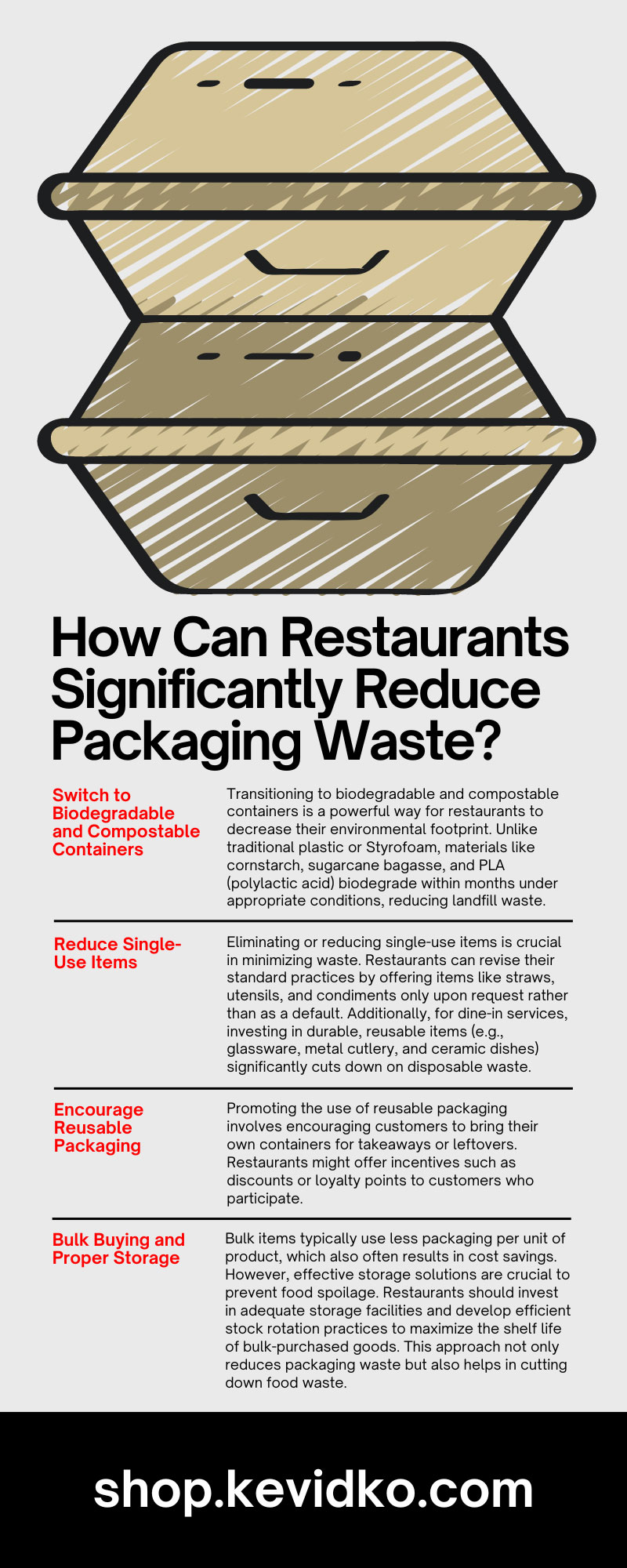How Can Restaurants Significantly Reduce Packaging Waste?
As the environmental impact of business operations becomes a growing concern, restaurants are increasingly called upon to minimize their waste, particularly when it comes to packaging. Here’s a comprehensive guide on how restaurants can significantly reduce their packaging waste, detailing practical and innovative strategies that not only contribute to environmental sustainability but also enhance operational efficiency and customer satisfaction.
Evaluate Current Packaging Use
Restaurants should start their journey toward waste reduction by thoroughly assessing their current use of packaging. This evaluation should encompass all areas of operation, from the delivery of ingredients to the packaging of take-out orders. Tracking the types and quantities of packaging regularly used helps identify key areas where reductions can be made. Restaurants can then pinpoint unnecessary packaging, such as excess food wrappers or overly bulky containers, and explore more sustainable alternatives. This initial assessment serves as the baseline from which to measure progress and develop more targeted waste reduction strategies.
Switch to Biodegradable and Compostable Containers
Transitioning to biodegradable and compostable containers is a powerful way for restaurants to decrease their environmental footprint. Unlike traditional plastic or Styrofoam, materials like cornstarch, sugarcane bagasse, and PLA (polylactic acid) biodegrade within months under appropriate conditions, reducing landfill waste. Restaurants should consider the specific needs of their service offerings—such as temperature tolerance and food safety—when selecting these greener alternatives to ensure that they maintain the quality and integrity of the food while enhancing sustainability efforts.
Reduce Single-Use Items
Eliminating or reducing single-use items is crucial in minimizing waste. Restaurants can revise their standard practices by offering items like straws, utensils, and condiments only upon request rather than as a default. Additionally, for dine-in services, investing in durable, reusable items (e.g., glassware, metal cutlery, and ceramic dishes) significantly cuts down on disposable waste. Communicating the reasons for these changes to customers can also help manage expectations and foster support for sustainable practices.
Encourage Reusable Packaging
Promoting the use of reusable packaging involves encouraging customers to bring their own containers for takeaways or leftovers. Restaurants might offer incentives such as discounts or loyalty points to customers who participate. This initiative not only reduces the demand for single-use containers but also actively involves customers in the restaurant’s sustainability efforts, creating a community of environmentally conscious individuals. It’s important for restaurants to ensure that any containers brought in by customers meet food safety standards to maintain health and hygiene.
Bulk Buying and Proper Storage
By purchasing ingredients in bulk, restaurants can significantly reduce the packaging waste associated with food delivery. Bulk items typically use less packaging per unit of product, which also often results in cost savings. However, effective storage solutions are crucial to prevent food spoilage. Restaurants should invest in adequate storage facilities and develop efficient stock rotation practices to maximize the shelf life of bulk-purchased goods. This approach not only reduces packaging waste but also helps in cutting down food waste.
Choose Suppliers Who Adopt Sustainable Practices
Collaborating with suppliers who prioritize sustainability can lead to significant reductions in packaging waste. Restaurants should seek out suppliers who are willing to deliver products in returnable, reusable, or minimal packaging. Partnering with local suppliers not only supports the local economy but also reduces the carbon footprint associated with long-distance transportation. By building relationships with these suppliers, restaurants can influence the supply chain to adopt more environmentally friendly practices broadly.
Train Staff on Waste Reduction Techniques
Staff training is essential for successfully implementing waste reduction strategies. Employees should be educated on the importance of sustainability and trained in specific practices that minimize waste, such as proper portioning, efficient packaging techniques, and the management of inventory to prevent spoilage. Regular training sessions can help ingrain these practices in the day-to-day operations of the restaurant, ensuring that all team members are contributing to the establishment’s environmental goals.
Streamline Menu Offerings
Streamlining the menu can lead to less waste in both food and packaging. By limiting the number of dishes offered, restaurants can simplify inventory needs, reduce the variety of packaging required, and minimize the risk of food spoilage. A more focused menu allows for more efficient use of ingredients and can improve the quality of the dishes served, enhancing customer satisfaction while supporting waste reduction efforts.
Implement Portion Control
Effective portion control is another significant factor in reducing waste. By optimizing portion sizes based on customer demand and feedback, restaurants can reduce leftover food, which in turn decreases the need for packaging materials used for leftovers. Training kitchen staff to consistently serve controlled portion sizes can help in achieving this goal, ensuring that customers receive enough food to satisfy their appetite without excessive leftovers.
Opt for Recyclable Materials
When biodegradable options are impractical, choosing recyclable materials is an excellent alternative. Materials such as paper, certain plastics, and metals can often be recycled, provided they are not contaminated with food waste. Restaurants should select packaging materials that are widely accepted by local recycling programs and educate customers on how to dispose of them properly. Promoting recycling not only helps reduce waste but also encourages a recycling culture among consumers.
Reuse Strategies for Packaging
Exploring reuse options for packaging can significantly extend its lifecycle and reduce waste. For instance, glass jars and bottles can be repurposed to serve or store other food items. Restaurants can also encourage suppliers to accept containers back for reuse. Establishing a system for safely cleaning and reusing packaging materials can transform how resources are viewed and managed within the restaurant industry.
Digital Ordering Systems
Digital ordering systems help cut down on paper waste by eliminating the need for physical menus and order slips. These systems allow customers to order via digital devices like tablets or smartphones, which not only reduces paper use but also enhances order accuracy and reduces food waste. Moreover, digital systems can streamline operations and offer valuable data insights, helping restaurants further optimize their processes and reduce waste.
Customer Feedback and Involvement
Engaging customers in sustainability efforts can significantly enhance their effectiveness. Soliciting feedback via surveys or comment cards on packaging choices and waste reduction efforts can provide insights that help further refine these initiatives. Additionally, involving customers by educating them on the importance of sustainability and how they can contribute promotes a collaborative environment conducive to achieving waste reduction goals.
Evaluate and Optimize Food Service Supplies
Finally, it's essential to evaluate and choose food service supplies carefully. Restaurants should prioritize supplies that are either made from recycled materials or are conducive to recycling. Consider options like paper straws, wooden cutlery, and biodegradable or recyclable food containers. Opting for quality food service supplies that align with sustainable practices not only helps reduce waste but also builds the restaurant's reputation as an environmentally responsible business.
Now that you know how restaurants can significantly reduce packaging waste, you can see that with thoughtful planning and a commitment to sustainability, it is entirely feasible to lessen environmental impact while still providing excellent service. Embracing these changes is not just good for the planet—it also resonates with increasingly eco-conscious consumers, setting your business apart as a forward-thinking, responsible entity in the hospitality industry.

Recent Posts
-
Why Portion Cups Are Essential for Condiments
Condiment service can make or break the dining experience at your restaurant or catering event. Why …Dec 18th 2025 -
Pros and Cons of Cardboard Catering Boxes
Selecting the right packaging is a fundamental decision for any catering business. The containers yo …Dec 11th 2025 -
How To Choose the Best Aluminum Foil Containers for Food
Selecting the right containers for your restaurant or catering business affects everything from food …Dec 10th 2025




